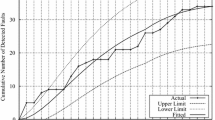Abstract
This paper discusses software reliability growth models (SRGMs) based on integrable difference equations, which are derived from the original nonhomogeneous Poisson process models by using Hirota’s bilinearization methods. After that, goodness-of-fit comparisons of our discrete models with existing deterministic discrete models are performed by using actual data sets. Further, we disucss discrete optimal software release problems under simultaneous cost and reliability requirements based on our discrete SRGMs.
Similar content being viewed by others
References
Yamada S, Osaki S (1985) Software reliability growth modeling: Models and applications. IEEE Trans Software Eng SE-11(12):1431–1437
Musa JD, Iannio D, Okumoto K (1987) Software reliability: Measurement, Prediction, Application. McGraw-Hill, New York
Yamada S (2002) Software reliability models. in Stochastic Models in Reliability and Maintenance, (ed. S. Osaki) Springer-Verlag, Berlin, pp. 253–280
Pham H (2000) Software Reliability. Springer-Verlag, Singapore
Yamada S, Ohba M, Osaki S (1983) S-shaped reliability growth modeling for software error detection. IEEE Trans Reliability R-32(5):475–478, 484
Hirota R (1979) Nonlinear partial difference equations.V. Nonlinear equations reducible to linear equations. J Phys Soc Japan 46(1):312–319
Satoh D (2000) A discrete Gompertz equation and a software reliability growth model. IEICE Trans Inform Syst E83-D(7):1508–1513
Satoh D, Yamada S (2002) Parameter estimation of discrete logistic curve models for software reliability assessment. Japan J Indus & Appl Mathemat 19(1):39–54
Satoh D, Yamada S (2001) Discrete equations and software reliability growth models. Proc. 12th Intern Symp Software Reliab Eng (ISSRE’01), pp. 176–184
Goel AL, Okumoto K (1979) Time-dependent errordetection rate model for software reliability and other performance measures. IEEE Trans. Reliab R-28(3): 206–211
Ohba M (1984) Inflection S-shaped software reliability growth model, in Stochastic Models in Reliability Theory, (eds S. Osaki and Y. Hatoyama), pp. 144–165, Springer-Verlag, Berlin
Yamada S (1994) Software Reliability Models: Fundamentals and Applications (in Japanese). JUSE Press, Tokyo
Brooks WD, Motley RW (1980) Analysis of discrete software reliability models. Technical Report RADC-TR-80-84, Rome Air Development Center, New York
Yamada S, Osaki S (1985) Cost-reliability optimal release policies for software systems. IEEE Trans Reliab R-34(5): 422–424
Author information
Authors and Affiliations
Corresponding author
Rights and permissions
About this article
Cite this article
Inoue, S., Yamada, S. Integrable difference equations for software reliability assessment and their applications. Int J Syst Assur Eng Manag 1, 5–10 (2010). https://doi.org/10.1007/s13198-010-0005-x
Published:
Issue Date:
DOI: https://doi.org/10.1007/s13198-010-0005-x




